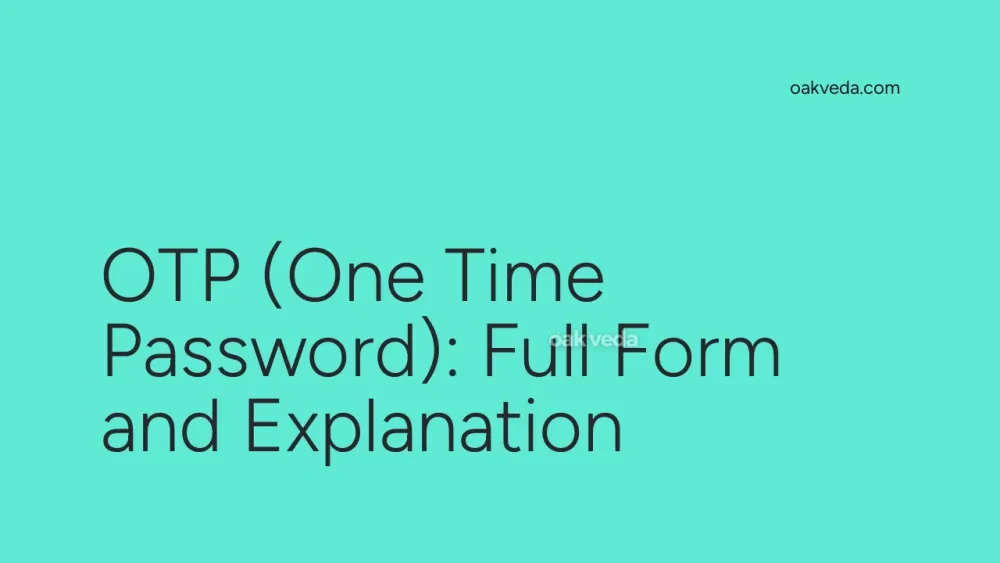
What is the Full Form of OTP?
OTP is the abbreviation for "One Time Password." This term is widely used in the realm of digital security and authentication processes. The full form of OTP represents a crucial element in modern cybersecurity measures, providing an additional layer of protection for various online activities.
What is One Time Password?
A One Time Password, commonly known as OTP, is a unique, automatically generated code that is valid for a single use or session. Typically consisting of 4 to 8 digits, an OTP serves as a temporary authentication mechanism, enhancing the security of digital transactions, logins, and other sensitive operations.
Origin and Development of One Time Password
The concept of One Time Passwords emerged as a response to the growing need for stronger authentication methods in the digital age. Traditional static passwords became increasingly vulnerable to various cyber threats, prompting the development of more secure alternatives. OTPs were introduced to address these security concerns by providing a dynamic, short-lived authentication factor.
How does One Time Password work?
The functioning of a One Time Password system involves several key steps:
- Generation: When a user initiates a transaction or login attempt, the system generates a unique OTP.
- Delivery: The OTP is sent to the user through a pre-registered channel, typically via SMS, email, or a dedicated mobile app.
- Input: The user enters the received OTP into the required field within a specified timeframe.
- Verification: The system verifies the entered OTP against the generated one.
- Authentication: If the OTP matches and is entered within the valid time window, the system grants access or approves the transaction.
Types of One Time Passwords
There are several types of OTPs, each with its own generation and delivery mechanism:
- Time-based OTPs (TOTP): These are generated based on the current time and remain valid for a short duration.
- HMAC-based OTPs (HOTP): These use a secret key and a counter to generate the OTP.
- SMS OTPs: Sent via text message to the user's registered mobile number.
- Email OTPs: Delivered to the user's registered email address.
- App-based OTPs: Generated by dedicated authentication apps on the user's smartphone.
Functions of One Time Password
The primary functions of OTPs include:
- Authentication: Verifying the identity of users during login attempts.
- Transaction Authorization: Confirming the legitimacy of financial transactions.
- Account Recovery: Facilitating secure password resets or account recoveries.
- Two-Factor Authentication (2FA): Serving as the second factor in multi-factor authentication systems.
Applications of One Time Password
OTPs find widespread applications across various digital platforms and services:
- Online Banking: Securing fund transfers, bill payments, and other financial transactions.
- E-commerce: Verifying purchases and protecting payment information.
- Social Media: Enhancing account security during logins or password changes.
- Government Services: Securing access to sensitive information and online services.
- Corporate Networks: Protecting remote access to company resources and data.
Features of One Time Password
Key features of OTPs include:
- Uniqueness: Each OTP is generated uniquely for a specific session or transaction.
- Time-Limited Validity: OTPs expire after a short period, typically a few minutes.
- Single-Use: An OTP becomes invalid after one successful use.
- Randomness: OTPs are generated using complex algorithms to ensure unpredictability.
- Multi-Channel Delivery: OTPs can be delivered through various channels for user convenience.
Benefits of One Time Password
The use of OTPs offers several advantages:
- Enhanced Security: OTPs provide an additional layer of protection beyond static passwords.
- Mitigation of Phishing Attacks: Even if a user's password is compromised, the OTP remains secure.
- Reduced Risk of Credential Stuffing: OTPs prevent the reuse of stolen login credentials across multiple platforms.
- User-Friendly: OTPs are easy to use and do not require users to remember complex passwords.
- Compliance: Many regulatory standards require multi-factor authentication, which OTPs can fulfill.
Limitations or Challenges of One Time Password
Despite their benefits, OTPs also face some challenges:
- Delivery Delays: SMS or email OTPs may experience delays, causing user frustration.
- SIM Swapping Attacks: Malicious actors may intercept SMS OTPs through SIM card fraud.
- Phishing Vulnerabilities: Sophisticated phishing attacks can trick users into revealing their OTPs.
- User Inconvenience: Some users may find the additional step of entering an OTP cumbersome.
- Dependency on External Factors: OTP delivery relies on network connectivity and device availability.
Future Developments in One Time Password Technology
The future of OTP technology is likely to see several advancements:
- Biometric Integration: Combining OTPs with biometric factors for enhanced security.
- AI-Powered Risk Assessment: Using artificial intelligence to determine when to require OTPs based on user behavior.
- Blockchain-Based OTPs: Leveraging blockchain technology for more secure OTP generation and verification.
- Passwordless Authentication: Evolving towards systems where OTPs replace static passwords entirely.
- Improved User Experience: Developing more seamless OTP entry methods to reduce friction.
FAQs on OTP Full Form
-
What is the full form of OTP? The full form of OTP is One Time Password.
-
How long is an OTP valid? Typically, an OTP is valid for a short period, usually between 30 seconds to 10 minutes, depending on the system.
-
Can OTPs be reused? No, OTPs are designed for single use only and become invalid after one successful use or upon expiration.
-
Are OTPs case-sensitive? Most OTPs are numeric and therefore not case-sensitive. However, some systems may use alphanumeric OTPs, which could be case-sensitive.
-
What should I do if I don't receive an OTP? If you don't receive an OTP, check your network connection and ensure your contact details are up-to-date. Most systems offer an option to resend the OTP if needed.
By implementing One Time Passwords, organizations can significantly enhance their digital security posture, providing users with a more robust and dynamic authentication method. As technology evolves, OTPs will continue to play a crucial role in safeguarding online interactions and transactions.
You may be interested in:

